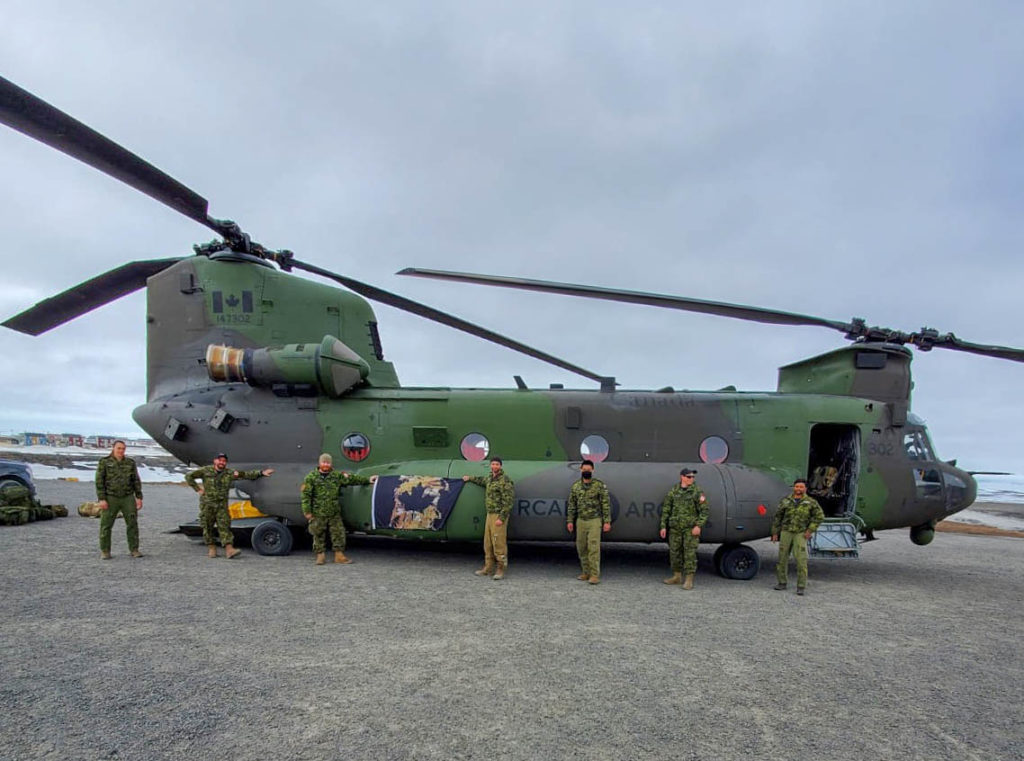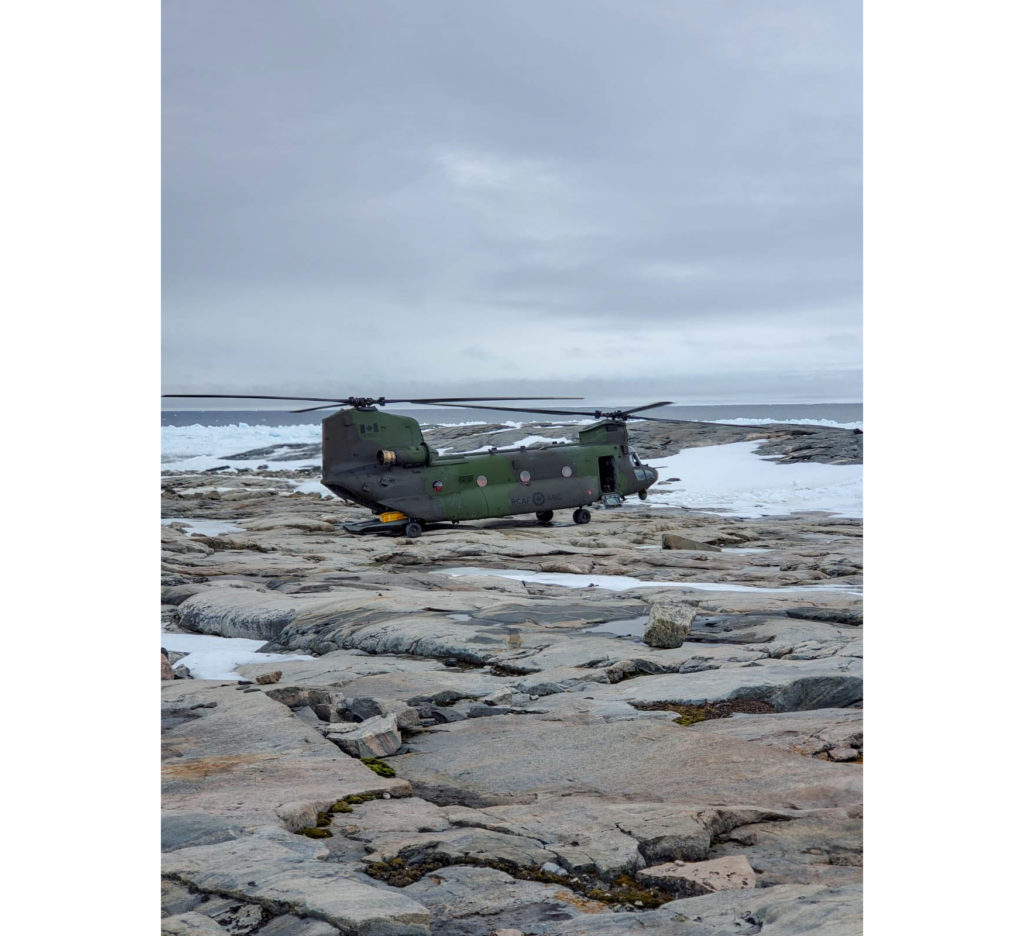Estimated reading time 7 minutes, 55 seconds.
450 Tactical Helicopter Squadron (THS) is located in Petawawa, Ont. At a time when much of the world is running on a reduced capacity due to the challenges of COVID-19, the “Vikings” of 450 THS have barely skipped a beat. The squadron continues to cover off a wide array of essential tasks and responsibilities that come with operating one of the most versatile and capable assets in the Canadian Armed Forces.

450 THS primarily focuses on providing tactical airlift, logistical resupply, and forward aeromedical evacuation to the Canadian Army and Special Operations Forces. 450 THS is also mandated to hold a stand-by posture in support of Operation Lentus at all times. Members on stand-by may be called upon to deploy domestically in support of local governments or other agencies that are in need of urgent help. Crews from 450 THS have deployed several times in recent history in order to provide disaster relief efforts. On the afternoon of May 27, 2020, a crew of seven “Vikings” from 450 THS were called upon by the Joint Rescue Coordination Center (JRCC) to complete a search and rescue (SAR) mission. SAR missions are normally handled by the SAR community; however, in the case of this mission, the SAR helicopter was tasked on standby elsewhere, and the Chinook helicopter was a logical choice given its range, speed, and lifting capability. This marks the first SAR mission the squadron has been tasked with since its re-inauguration in 2012.
Initial information outlined that several people had been stranded on a small island in Hudson Bay near Puvirnituq, Que., due to ocean conditions and needed evacuation. Capt Augustine Monteiro, the aircraft commander, determined they could reach the stranded persons in approximately seven hours of flying time with only one fuel stop. 450 Squadron’s operations cell, maintenance, logistics and crew members put a pause on their other tasks and banded together to help with pre-mission preparations in order to enable the earliest possible departure.
At 4:00 a.m. on May 28, 2020, the crew members of “Rescue 302” arrived at the unit, rested and ready to deploy. The aircraft was airborne by 6:15 a.m. and four hours later the crew arrived at La Grande Rivière airport, their planned fuel stop. On their way there, the crew had to deviate from their flight planned routing to find a way around poor weather. The updated information received by the crew was that 13 Inuit hunters, including two infants and two children, had crossed onto Millet Island on an ice bridge which had since broken up. A CC-130 Hercules had dropped them a bundle of survival gear to sustain them until Rescue 302 could arrive.

At approximately 3:15 p.m., Rescue 302 landed at a small airfield in Inukjuak, Que., for their last planned stop prior to the evacuation of Millet Island. At the sight and sound of the Chinook helicopter, some of the locals exclaimed that the presence of Canadian Armed Forces troops made them feel safe given all of the problems going on in the world. The crew donned their immersion suits for the impending flight over freezing cold water. Not only was this to be the first dedicated SAR mission 450 THS had been tasked with, but it would also be one of the unit’s first experience crossing a major body of water.
Soon after departing Inukjuak, the crew discovered that there was more poor weather between them and the island. The melting ice over Hudson Bay and a local weather system generated an endless amount of low cloud layers and poor visibility due to the fog. With all eyes out, the crew was able to find pockets of clear air to cut through while keeping the aircraft out of harm’s way. During the transit, the crew had the benefit of knowing that the stranded Inuit hunters were experts at surviving off the land, and the air-dropped survival equipment they had received the night prior would provide them with several days of supplies if required. Nonetheless, there was still a sense of urgency to get to them as quickly and safely as possible. The crew made quick work of the weather challenges along the way and arrived on scene at 4:50 p.m.
Millet Island was filled with clusters of lichen-covered black rock. No signs of life were observed. The crew orbited the island a few times and checked the two nearby islands to ensure that they did not miss anyone. Since the crew had come this far, they decided it would be worthwhile to land and search a small shack that was standing at the centre of the island. They had to work hard to find a suitable landing spot on the rocky terrain, which seemed much flatter from the air. The flight engineer and a technician departed the aircraft to search the structure and look for any signs of the stranded group. All that was found were the remains of the hunters’ caribou kills and some military rations from the airdropped bundle. With no signs of anyone left behind, the crew determined that the stranded hunters must have found a way through the moving ice, back to the mainland. After a thorough search, Rescue 302 departed Millet Island and landed in Puvirnituq airfield, where they would spend the night.
Upon their arrival at their final destination for the day, the crew was greeted by the Kativik Police Force who informed them that the stranded individuals had successfully found their way back to the mainland a few hours prior. They had taken a risk by crossing a gap in open water to find ice that led back to the mainland. Upon hearing the news, the crew members of Rescue 302 all took a collective sigh of relief knowing that all of the people stranded in Hudson Bay had made it home safely. After completing post-flight inspections and unpacking some warmer clothing, the crew buttoned up the aircraft for the night and were shuttled away to a house in the village in police trucks. The police detachment was extremely thoughtful and accommodating, giving crew members a lift when needed and arranging food and water for dinner. Rescue 302 would like to thank the police detachment in Puvirnituq for their excellent assistance.
Although in the end 450 THS did not pick up the stranded persons, this callout allowed the unit to test their standby posture and provided excellent training for the crew in conditions not normally flown in. It also allowed the squadron to have a presence in the North, in a location which they do not often have the opportunity to fly to.









Great work 450 THS